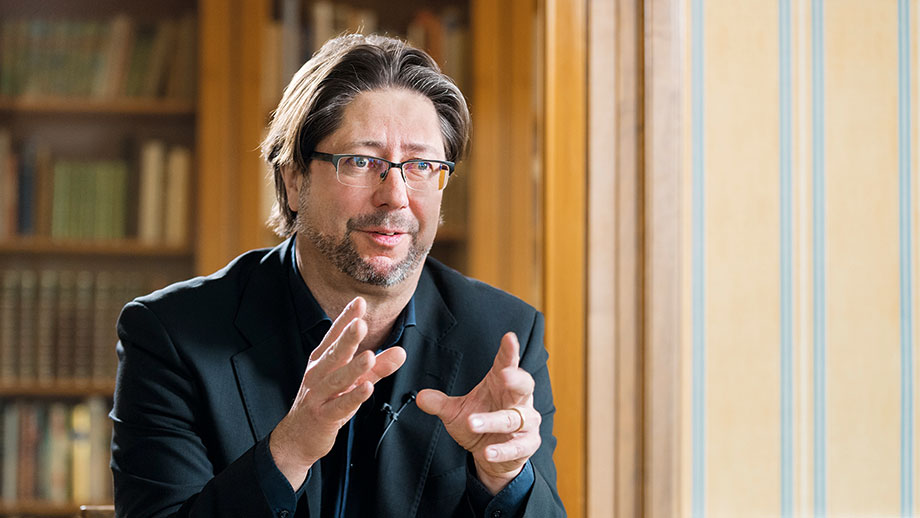Living Diversity

The academic program reforms in the Faculty of Arts and Social Sciences are bearing fruit. Over 100 attractive Master’s programs, many of them new, will be available to students from the Fall Semester 2019 onward.
By David Werner
The UZH Faculty of Arts and Social Sciences is huge, accounting for two-fifths of the student body matriculated at the University. And it is complex as well: No other faculty offers more study programs, and the combination possibilities border on endless. Accordingly, the administration of its operations has been complicated and costly.
Above all, though, the Faculty of Arts and Social Sciences is uniquely diverse. Its spectrum of academic disciplines ranges from prehistoric archaeology to computational linguistics, from musicology to political science, and from South Asian studies to vocational pedagogy. This diversity isn’t just fascinating, but is also a defining quality factor in the arts and social sciences. “Whoever wishes to scientifically observe, ponder and understand society in its complexity, humankind as it has been shaped by history, cultures in their interrelations and the evolution of forms of communication crucially requires a diversity of viewpoints,” says literary scholar Daniel Müller Nielaba, adding, “the arts and social sciences owe their productivity to the wealth of different perspectives, mindsets and methodologies.”
Milestone reached
Finding a way to live this diversity in the future and to fruitfully harness it in education was and remains the central challenge in reforming the curriculum in the Faculty of Arts and Social Sciences, Müller Nielaba avers. As the vice dean of studies, he has spent the last three years driving the implementation of the Bologna 2020 reform project. In the wake of the introduction of the new degree program structure in the Faculty of Arts and Social Sciences at the Bachelor’s level in 2017, the Master’s level is next in line this fall, marking the achievement of a major milestone. “Our new catalogue of degree programs doesn’t simply replicate the spectrum of academic disciplines, but also enables students to derive the greatest possible benefits from this diversity,” declares Müller Nielaba with pride.
Specialized and generalist all at once
The job of revamping the Master’s degree programs was much like squaring a circle in many respects, says the professor, looking back. “Our stated goal was to give Master’s students the possibility to develop their own preferences and to work their way into special subject areas. At the same time, though, they should also have options to acquire a thorough overview of their chosen fields. The study programs should provide sufficient latitude for personal discovery, but at the same time should clearly signal the path to a degree so that students don’t get lost in the thicket of possibilities.” In short, the aim with the new degree program structure was to take the fascinating richness of possibilities in the Faculty of Arts and Social Sciences into account while keeping things manageable and easily surveyable. Achieving that goal required a lot of commitment from everyone involved.
Opportunity seized
Given its numerous institutes, departments and fields of knowledge, revamping curriculum offerings is always an especially challenging endeavor for the Faculty of Arts and Social Sciences. The Bologna reforms were perceived as a stinging blow to the self-conception of the social sciences, and of the arts even more so. The initial reform attempt after the turn of the millennium thus proceeded rather unsatisfactorily. In an effort to preserve proven features of the old system in the new one, the faculty got more than it bargained for: A web of regulations that turned out to be inexpedient in practice. Too many exams, insufficiently large modules, too many admissions barriers and too many special provisions made studying in the faculty more difficult and caused an inordinate amount of administrative red tape.
In 2016, the Board of the University enacted a university-wide model framework ordinance to harmonize study program structures throughout UZH’s seven faculties and to thus increase the freedom to choose between the degree programs in the different faculties. This made a renewed revision of the Faculty of Arts and Social Sciences’ degree program structure inevitable. This time, though, the faculty didn’t want to make a superficial show of going through the motions, but instead wished to use the opportunity to review its existing academic structures from the ground up and to improve them where needed.
No degrees without a connection to the next level
A matter of great importance in the reform process was the ability to combine study programs for both full-time and part-time students. Striking improvements were achieved in this area: “There are no more Bachelor’s degrees that don’t have a systematic link to the Master’s level,” says Müller Nielaba. Special conditions and restrictions on transitioning from the Bachelor’s to the Master’s level were dismantled, and it has been made easier for a transitioning student to choose a course of study in line with their interests. One other big advancement is that the formerly compartmentalized and overregimented study programs with their tight exam schedules will now be structured more liberally. The new and revamped programs are composed of fewer but larger modules. This gives students more discretionary latitude to shape their courses of study and fosters deep and effective learning.
More cooperation, less regulation
A fundamental reorientation of the faculty with regard to the conceptual design of its study programs and modules was a prerequisite to substantially enhancing the attractiveness of the programs. “The new degree program structure operates with less regimentation than the previous one did and instead relies on greater cooperation between teaching staff,” explains Müller Nielaba. Instructors must work together more intensively than before when planning courses, because most of the large modules involve multiple instructors who sometimes belong to different institutes or departments – or even to different faculties. The priorities and specialties of the individual professorial chairs are no longer the focal point in course planning; curriculum planning now centers on the knowledge and skills that students should acquire during a module and by the end of their degree studies. For many departments and institutes in the Faculty of Arts and Social Sciences, implementing the reform objectives means undergoing a radical cultural transformation. The traditional professorial chair system is evolving toward a model of greater cooperation. Monika Dommann, a professor of modern history in UZH’s Department of History, recounts the many intense discussions she says were needed to reach a common understanding on how to design study programs and modules in the future. “Actively shaping the reforms required an enormous effort from everyone working in the Department of History,” she says. “The comprehensive revamping process, with its highly technical jargon and hyper-meticulous guidelines, strained our manpower to the limit.” What really matters in hindsight, though, is the outcome. Professor Dommann affirms that it was definitely worth all the effort. She is confident that the overhauled curriculum offerings will benefit students and teaching staff alike. “The intense teamwork between different professorial chairs in planning and running study programs and modules is an enrichment for everyone involved in education,” she says. “The university’s diversity is truly being lived out to the fullest this way.”
Curriculum reforms in the Faculty of Law
The Faculty of Law is also in the process of comprehensively revamping its degree programs for launch in the Fall Semester 2021. Its Bologna 2021 project affects all study programs in the Faculty of Law and is accordingly complex and extensive. The faculty’s aim with the project is to enhance academic quality across the board. It kicked off the project in February 2018 with a round of talks held with high-ranking figures in the legal profession to ascertain the strengths and weaknesses of law graduates. It then drafted an internal mission statement and set of guiding principles for the study of law that envisage more intensive teaching of the core skills needed in the legal profession and lay the framework for reforming the curriculum. In October 2018, the faculty approved a rough conceptual blueprint for the Master’s-level curriculum, which had previously never been reformed. The new concept envisages compulsory modules in core practice-oriented subject areas making up one-third of the Master’s degree program. The Faculty of Law is currently drafting a detailed concept plan for the entire Master’s program. The Center for University Teaching and Learning is closely involved in the makeover.
Alain Griffel, Vice Dean of Studies, Faculty of Law





